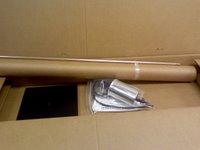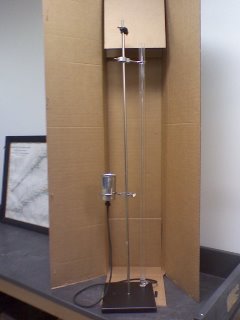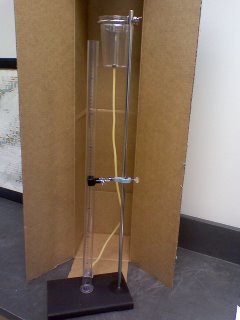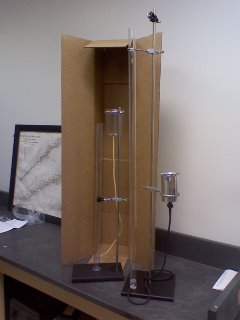This morning the blogs and twitter feeds were linking all over the place to a passive amplifier for your iPhone. (See it here: Science & Sons OS v1.0)
The idea behind a passive amplifier is that it requires no electrical power to increase the amplitude of the sound wave which is presented to your ear. Just pop your iphone into the cradle and crank up the tunes. As long as the battery in the iphone is charged, you have amplified sound.
It sounded cool, so I checked it out. This is what caught my eye:
The Phonofone III is an elegantly designed passive amplifier crafted from ceramic and designed explicitly for iPhone. This clever device amplifies the volume emited from an iPhone internal speaker roughly 4x (approx. 60 decibels).
Wait. What? I get a 60 dB gain out of a device with no power? Let's see if that passes the sanity check. I don't have an iphone, but I have heard the iphone playing audio from its internal speaker. Unamplified, at a moderate level, I would say the sound level observed from an ipod (at an average distance) is about the same as the sound level of a typical conversation. Let's look at what the approximate sound level would be:
(I found this chart on OSHA's website. I assume the image is public domain, like most government images.) From the chart you can see that conversation at 1 m is approximately 60 dB(A). (The "A" means A-weighted, which is a weighting factor used to approximate the frequency response of the human ear.) Let's be conservative and estimate the iphone unamplified level to be about 55 dB. That means that if I drop the iphone into the passive device the sound level should be 55 dB + 60 dB = 115 dB. That's louder than the "Discotheque" rating in the chart (when/where was this chart generated?) which is also about 20 dB louder than a jackhammer at 15 meters. Somehow I really doubt that the single horn + iphone is going to be able to compete with the speakers and amplifier of a dance club.
What about the other claim? They say the sound will be about 4x louder. Here's where the claim might hold some water. The basic idea of a horn is to provide better impedance matching between the driver and the sound field and to control directivity of the sound radiation. Assuming the horn is pointing at an observer, the sound level at the observers ears should be higher with the horn than without the horn.
What if their claim that using the horn causes a perceived 4x increase in loudness is true? (Loudness is a perceptual quantity, where sound level - either sound pressure level or sound intensity level - is a measured quantity.) Then, the only mistake that they made is equating a 4x increase in loudness with a 60 dB gain in sound level. Here's a graph from a lab we do in my "Sound and Acoustics" class:
In this lab students hear a broadband tone which they assign an arbitrary loudness level rating. In this class, we all agreed to call the reference tone (relative sound level = 0 dB) a loudness level of 100. Note, there are no units, since it's an arbitrary scale we made up for the lab. Then they hear several other tones where the level has been increased or decreased randomly and they are asked to rate the loudness of the tone with respect to the loudness of the reference tone.
What I've plotted above is the class average of loudness level vs the actual relative sound level (in dB) for all trials. Each sample was presented twice (not in sequential order) so the scatter is a sort of approximation to the uncertainty in the measurement. The solid line represents a model that is what we would expect to see for a larger sample of the population. For such a small class, the trend is pretty close to the "expected" behavior.
Note that a 4x increase in loudness, from either 25 to 100 or 100 to 400, corresponds to a relative gain in sound level of 20 dB, not 60 dB.
Under ideal testing circumstances, I could believe that a passive amplifier like the horn amp would give a 20 dB gain right in front of the horn. But someone should have caught the 4x = 60 dB nonsense.






